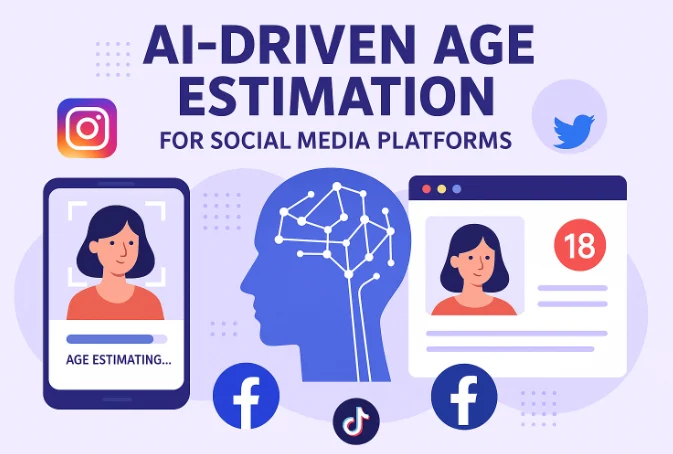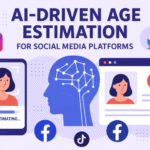
How Social Media Platforms Are Reinventing Age Verification Standards
One of the burning issues of social media over the recent years is age verification. As their user bases in the world count billions, and the number of young user groups continues to continue growing, platforms are subject to more scrutiny by regulators, parents and advocacy groups to make sure that minors do not see harmful or otherwise age-restrictive content. Conventional ways, including self-declared birthdates have already been found to be unreliable, thereby compelling businesses to seek more sophisticated and technology-based solutions.
Table Of Content
- The Increasing Significance of Age Verification
- Traditional Checks to AI-based Approaches
- AI-Based Age Estimation
- Document Verification
- Contextual and Behavioral Analysis
- Weighing the Right to Privacy and Protection
- Industry Co-operation and Standards
- Implementation problems
- The Future of Age Checking in Social Media
- Conclusion
With privacy, security, and user experience remaining important issues, age verification is being reformulated by social media sites so as to make the internet a safer place to be without disregarding the rights of the user.
The Increasing Significance of Age Verification
Over the years, the majority of social media sites used a basic date of birth entry field to prevent underage users. Nevertheless, they are not very difficult to circumvent, and children are able to get to sites that are not intended to be used by them. This is the gap that has brought about much concern:
- Viewing violent, misleading or sexually explicit content
- Grooming and exploitation (predatory risks)
- Legal and reputational threats of platforms that do not adhere to child protection laws
Stricter rules have been introduced or are proposed by regulators around the globe such as the European Union, the U.S., and the UK. To take a specific example, the Online Safety Act in the UK and the Digital Services Act in the EU both focus on child safety and require more intense age-verification models. These regulatory influences have compelled the social media firms to be innovative.
Traditional Checks to AI-based Approaches
The concept of artificial intelligence (AI) and machine learning is one of the main factors that lead to the reinvention of age verification standards. AI provides scalable, less invasive and more accurate ways of age verification of users compared to manual inspection or simple sign-up barriers.
AI-Based Age Estimation
The platforms are currently testing AI-based facial recognition applications that are used to guess a user’s age on the basis of a selfie or video. Such companies as Yoti and other age-tech services collaborate with social media marketing networks to implement this technology.. Such solutions do not need that the biometric information be stored, rather, it examines trends including: facial structure, skin texture and movement to come up with an informed age guess.
Document Verification
Digital identity document verification is also another technique that is becoming popular. Users can be requested to provide an ID issued by the government (i.e., a passport or a driver’s license) which can be automatically compared with databases or authenticated by machine learning algorithms. Although this is effective, it causes privacy, and access issues especially to minors who are not ID holders.
Contextual and Behavioral Analysis
There are platforms that are looking into using behavioral data as a means of age verification. Ai can understand the typing habits and the things that users view and how they use them to determine whether they are underage or not. This approach would eliminate the need to take any intrusive actions in order to verify the identity, but has to balance with privacy expectations.
Weighing the Right to Privacy and Protection
A major problem when reinventing age verification is that solutions should not violate the privacy of users. Gathering sensitive information like biometrics or government-related documents may be dangerous unless taken care of. Social media is implementing new tactics to contain this challenge:
- Age verification AI models that do not store raw data
- Temporary data processing, in which documents or selfies are verified but not stored
- Third-party verification services, which are used as intermediaries thus making platforms to have no direct access to sensitive data
Such strategies are in line with the data protection laws including General Data Protection Regulation (GDPR) which focuses on minimal data gathering and user consent.
Industry Co-operation and Standards
Individual platforms have not only the responsibility of reinventing age verification. The entire industry is headed towards common standards and partnerships. There are efforts underway to establish interoperable structures, such as the Age Verification Providers Association (AVPA), which can be implemented in a variety of platforms, making them consistent and reliable.
The governments are also taking a leading role by putting in place code of practices and promoting public- private alliances. As an example, certain regulators are discussing the use of digital identity wallets or government-issued online credentials that may be incorporated effortlessly into social media age checks.
Implementation problems
Although it is observable that progress is being made, age verification reinvention has its challenges:
False Negatives and Positives: AI tools are prone to mistakes in terms of age categorization, which can block the legitimate users or give access to minors.
Worldwide Availability: In most places, users do not have official documents or good internet connections and document-based solutions are therefore not possible.
User Experience: Excessive verification can become a lot of frustration to the users, who are likely to engage less or leave the platform.
Ethical Issues: Face recognition and biometric technologies are associated with the concerns of surveillance and improper use of personal information in the long run.
The social media companies have just to create a balance between the security, usability, and ethical responsibility.
The Future of Age Checking in Social Media
In the future, the age verification standards will probably keep on changing and developing in various ways:
Decentralized identity systems: Digital IDs based on blockchain technology might enable users to prove their age without exposing their sensitive documents on many occasions
Tighter parental controls: Sites will probably incorporate functions that would enable parents to track and authorise the actions of children in a more efficient way.
Global digital identification systems: International organisations and governments can also implement a universal identity system where age verification is not an issue on any platform.
Hybrid models of verification A combination of AI-driven estimation, document verification, and behavioral verification will offer a layered security against underage.
Conclusion
Reinvention of age verification standards is altering the nature of social media sites to safeguard young users without compromising accessibility and privacy. AI-based facial estimation, digital identity verification, and behavioral analysis are just some of the new tools being embraced by platforms to deal with regulatory, ethical, and social issues. It is not to say that the challenges will disappear, especially regarding the question of privacy, global availability, and the trust of the user, but the trend is evident age verification is no longer going to be a box-ticking exercise but an element of responsible social media regulation.
Through adoption of new innovative technologies and cross-industrial cooperation, social media services are establishing secure virtual worlds with security and privacy becoming inseparable.



